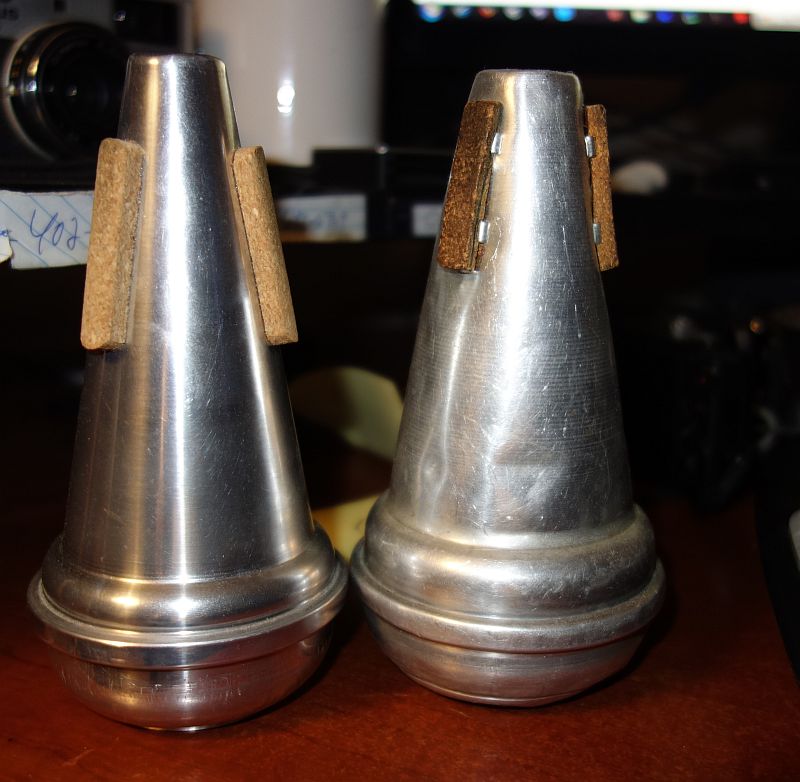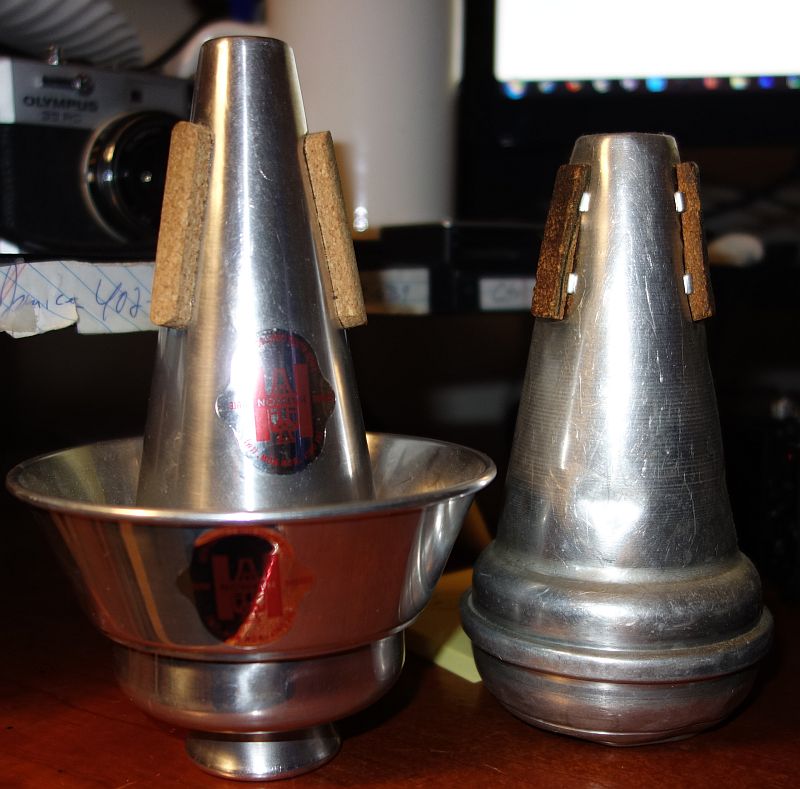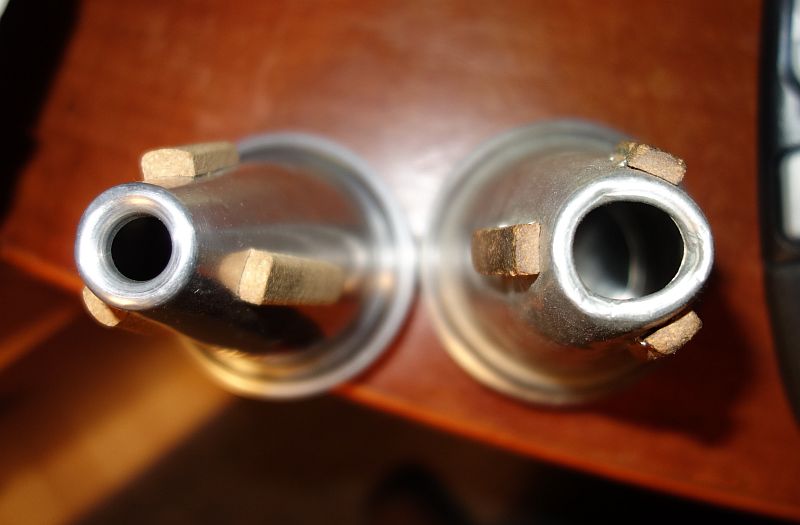Mute Musings
-
My community band’s holiday concert playlist is mute intensive. We had 15 trumpets show up for this week’s rehearsal, six were on 1st parts, six were on 2nd parts, and there were three of us on 3rd. Several of our numbers have prominent 3rd parts. I had selected my mutes based upon intonation and how they sound while practicing, which was a mistake in some respects.
My old Leblanc stemless Harmon worked great, it fits the bell on my old Severinsen just right, sounds good, and I could produce appropriate volume with it. My old Shastock straight mute (with maple resonator!) worked good too, but some of our mute changes are pretty quick and I worry about dinging the inside of my bell with the brass fitting on its insertion end, so I think I’ll go back to my standard red and white H&B.
The cup mute was my major disappointment. I had been using this old slightly misshapen black and white cup mute that came to me with some ratty black fabric glued to the inside of the cup portion. One of our numbers has the entire trumpet section playing cup muted harmonized parts. My sound simply disappeared with this old cup mute in my bell, along with the balance in our section. I’ll be using a standard red and white H&B cup mute going forward, I get much more volume when using it.
If this ramble has a point, it is this: There is much to consider when making mute selections!
Jim
-
I'm not much of a mute guy. My house is far enough away from the neighbors that I can play all I want without one and the neighbors don't know that I am even playing....I think. As a collector I've picked up a few as lagniappe with various horns. I do know professional players prize their mutes and I have parted with a couple to a guy that was on the old site that lusted for a couple I had and I could have cared less about and he was someone who actually played for money so was glad to let him have them.
One thing that intrigues me is that my old Harmon from the early 60's is different from the modern Harmon that looks generally the same. The newer one is smaller with a narrower cone. The two piece mute looks deceptively the same...but they aren't. Don't know what happened to the cup part of my old mute. I sometimes wonder what became of it.



-
Though I have all the needed mutes, cup, straight etc., I'm not a fan of using them, with the exception of my old dented Harmon Wow Wow that I like to use for certain ballads. Our band occasionally calls for a straight mute or a plunger ( the rubber toilet variety available at any hardware store ) but not too often and that suits me just fine.
-
@Comeback said in Mute Musings:
If this ramble has a point, it is this: There is much to consider when making mute selections!
Jim
You make a mute point. Actually an interesting thread topic!
-
I have also found that mutes can change performance by just changing the condition of the cork. My 1960's version original Harmon has the cork wearing down more and more. The more it has worn, the better it is sounding.
By the way if Trumpetsplus is reading this, you posted a comment with a diagram on cork thickness once on TM. If you still have this, could you post it here once again, as it will soon be time that I will need to replace the cork on that aging Harmon mute. Much thanks in advance!
-
@Niner said in Mute Musings:
One thing that intrigues me is that my old Harmon from the early 60's is different from the modern Harmon that looks generally the same...
This is particularly relevant with the wha wha Harmon mute. I have a 60's vintage (noted above) and a 2010 vintage and while they look more similar there is definitely a feel difference in the aluminium AND definitely a sound difference. That 60's vintage is so dark and rich (albeit the cork is worn). While the 2010 has a more metallic sound (with an intact cork character).
Of interest, that 60's vintage fits my Committee and Harrelson like fine leather racing gloves, but the 2010 just is impossible to keep in tight with those horns. Alternatively, the 2010 version fits my other horns much better. So is it the cork or the design?
-
Corks are meant to be sanded so they properly fit the bell. Since bell flares can be very different, sometimes when you get a new horn you need to replace your mute corks. Mutes that fit my last daily player well needed replacements to fit my current horn correctly.
-
@flugelgirl said in Mute Musings:
Corks ar meant to be sanded so they properly fit the bell. Since bell flares can be very different, sometimes when you get a new horn you need to replace your mute corks. Mutes that fit my last daily player well needed replacements to fit my current horn correctly.
Just what I was thinking. My latest trumpet acquisition has a larger flare and my usual harmon mute just fell out of the horn. Bought a new one and all is good. I also have a very small flared horn and that one took a lot of shaving of corks to get a good fit.
-
@Richard-III a quick and easy recork for a Harmon is sticky back craft foam - cheap, easily removable, and easy to fit. It’s also a bit thicker, so it may help make your older Harmon fit if you want to recork it. It also lets you just put the mute in with a twist instead of having to breathe in the bell. I did this on my bubble and it worked great! Had no need with my zinger - the cork on that one is quite thick and fits my A1 perfectly.
-
@flugelgirl said in Mute Musings:
Corks are meant to be sanded so they properly fit the bell. Since bell flares can be very different, sometimes when you get a new horn you need to replace your mute corks. Mutes that fit my last daily player well needed replacements to fit my current horn correctly.
If I remember correctly, we affect intonation of our muted trumpet by sanding/filing our mutes.
I bought a new Getzen 900 Eterna Classic a few years ago which I intended to make my primary horn. It was well-nigh perfect for my purposes. I carefully filed straight, cup, and Harmon mutes to fit the bell of the this horn securely, and to adjust intonation for each mute as well. The outfit worked just great. Regrettably, I sold this fine horn when I thought I would have to give up trumpet playing for health reasons - I kept the mutes, though.
Late this summer I lucked into an excellent mid-1970s Getzen Severinsen, which quickly became my primary horn. Fortunately, those mutes which were fitted so carefully to the departed Classic work pretty well. A few stokes with my four-in-hand file should have them fitting the Sev perfectly.
Jim
-
@Comeback said in Mute Musings:
...The cup mute was my major disappointment. I had been using this old slightly misshapen black and white cup mute that came to me with some ratty black fabric glued to the inside of the cup portion. One of our numbers has the entire trumpet section playing cup muted harmonized parts. My sound simply disappeared with this old cup mute in my bell, along with the balance in our section. I’ll be using a standard red and white H&B cup mute going forward, I get much more volume when using it...
JimYou can't go wrong with the H&B fiber cup mute. I see a lot of Wick adjustable cup mutes being used as the modern "standard", but to my ears, the H&B has the classic cup mute sound.
-
@flugelgirl said in Mute Musings:
Corks are meant to be sanded so they properly fit the bell. Since bell flares can be very different, sometimes when you get a new horn you need to replace your mute corks. Mutes that fit my last daily player well needed replacements to fit my current horn correctly.
That's why H&B put rubber fittings on their Harmon Wah-wah. These fit any horn and won't tumble out.
-
I don't intend to go into discussions of which mute to use where. I'll just add a small hilarious anecdote... Once, while playing in a certain orchestra, the piece had the two trumpets using harmons... first with the stem in, then with the stem extended and finally with the stems out. Unfortunately, we had only one and a half bars to get the extended stems fully out, so we had to take the stems out while leaving the mute in... you can imagine what happened. At the strategic moment, not only the stems came out, but the mutes as well... and there was a well-synchronized "kerlunk" as two Harmons hit the stage floor almost simultaneously...
-
Mutes, the bane of my life. Most of my playing is in theatre pit bands. I’ve probably spent more money on mutes for shows than I’ve been paid. Hat mute, Cleartone, metal and fibre straight mutes, metal and fibre cups, plunger, felt mute, even an extra Harmon because there wasn’t enough time to remove and replace stem between use. Sometimes I feel more like a juggler than a trumpet player. Why those that write scores don’t understand the player’s time requirements is a mystery. The puzzled face of an MD when you ask "Do you want this passage with a cup, or straight? Because you can’t have both. I physically cannot change mutes on a quaver rest".
-
Never filed a mute in my life. Aren't they made with malleable corks that work themselves in?
-
@Rapier232 said in Mute Musings:
Mutes, the bane of my life. Most of my playing is in theatre pit bands. I’ve probably spent more money on mutes for shows than I’ve been paid. Hat mute, Cleartone, metal and fibre straight mutes, metal and fibre cups, plunger, felt mute, even an extra Harmon because there wasn’t enough time to remove and replace stem between use. Sometimes I feel more like a juggler than a trumpet player. Why those that write scores don’t understand the player’s time requirements is a mystery. The puzzled face of an MD when you ask "Do you want this passage with a cup, or straight? Because you can’t have both. I physically cannot change mutes on a quaver rest".
Many of these parts were originally written for two players. One to play the straight, and the other to continue with the cup. Unfortunately, modern orchestras don't work that way.
-
@Rapier232 said in Mute Musings:
I physically cannot change mutes on a quaver rest".
And when you attempt to do this, bells are at high risk to get scratched and dented!
-
@Kehaulani said in Mute Musings:
Never filed a mute in my life. Aren't they made with malleable corks that wok themselves in?
Your experience with this stuff is greater than mine, Kehaulani. However, I have found that a little careful filling or sanding shortens that working in process considerably and improves intonation and fit immediately.
-
@Kehaulani
My Cleartone mute actually says on the label, ‘Corks may need filing’. -
Yeah, I'm not meaning to imply that no one needs to do this. Just stating that I never did that.